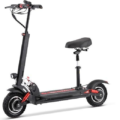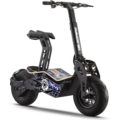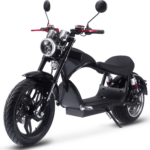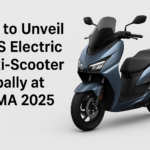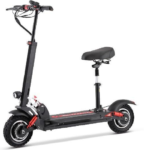- Home
- Scooters
- Electric Scooters
- MotoTec Fat Tire
MotoTec Fat Tire
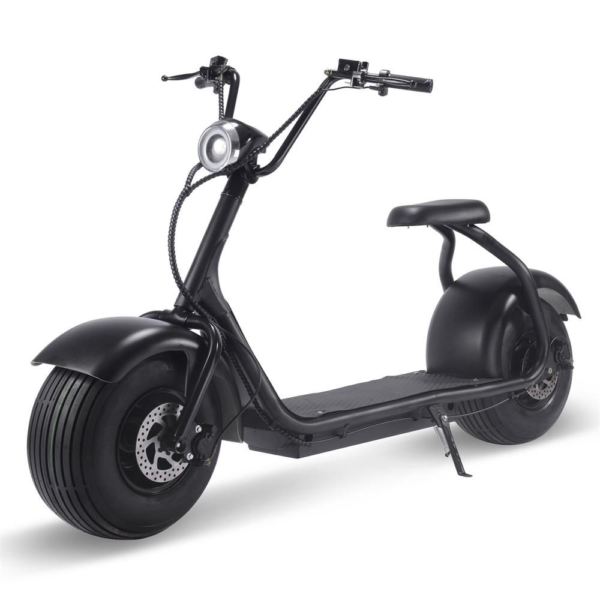

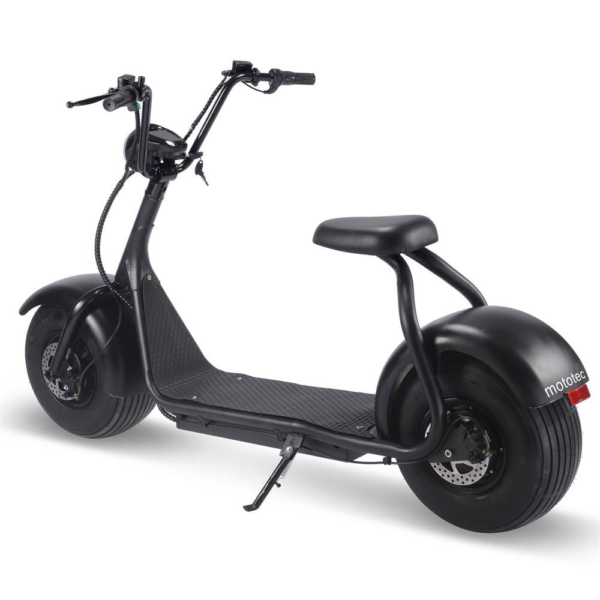
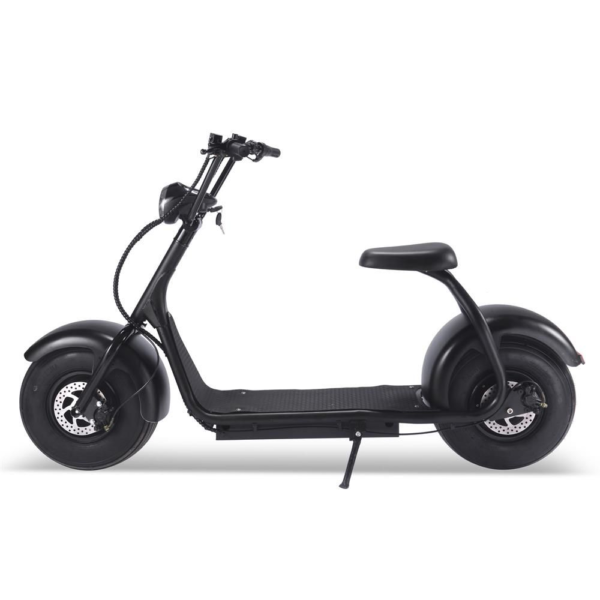
- Battery Range: 20 miles (32 km)
- Top Speed: 32 mph (52 km/h)
- Motor Power: 2000 W
- Weight Capacity: 300 lb (136.1 kg)
- Charging Time: ~4–8 h
- Scooter Weight: 123.0 lb (55.8 kg)
PROS
- 32 mph top speed from 2000W motor
- Hydraulic disc brakes front & rear
- 225/55-8 fat tires
- 3 selectable speed modes (11/20/30 mph)
- Relatively lighter frame for class (123 lb)
CONS
- No suspension (comfort from tires only)
- Range around 20 miles can be limiting
- IP rating not specified
- Very heavy vs. stand-up scooters


Key Takeaways
- The MotoTec Fat Tire is a sit-down electric scooter designed for comfort and stability on private roads, featuring a 2,000-watt motor and 60-volt battery.
- With a score of three speed settings, it offers speeds up to 30 mph and a riding range of 20+ miles depending on conditions.
- Its design includes hydraulic disc brakes, a high-tensile steel frame, and wide pneumatic tires for a smooth ride over various surfaces.
- The scooter is not street-legal and is best suited for homeowners with garage space rather than portability seekers.
- Ideal for new riders or those valuing comfort, the MotoTec Fat Tire isn’t suitable for tight storage or extensive daily range needs.
Table of contents
- What Is the MotoTec Fat Tire?
- How the MotoTec Fat Tire Works
- Key Specifications
- Design & Build Quality
- Performance Fundamentals
- Battery, Range & Efficiency
- Ride Quality & Comfort
- Braking & Safety Features
- Portability & Daily Usability
- Maintenance & Care
- Weather & Seasonal Considerations
- MotoTec Fat Tire vs Alternatives
- Who the MotoTec Fat Tire Is (and Isn’t) For
- FAQs
- Glossary
The MotoTec Fat Tire is a sit-down electric scooter built for chill, low-stress rides. It uses a wide tire setup, a 2,000-watt rear hub motor, and a 60-volt lithium battery. It fits riders who want easy stability on neighborhood streets or private property, not a fold-and-carry commuter. So if you want comfort, simple controls, and a tough frame, this one makes sense based on its official specifications.
What Is the MotoTec Fat Tire?
The MotoTec Fat Tire is a heavy, wide-tire scooter with a seat and motorcycle-style bars. It rides like a tiny cruiser. You sit down, twist the throttle, and glide over cracks that bother smaller scooters. The big pneumatic tires act like simple air springs, so the front end kicks less and your hands relax more. Then, when you need to stop, hydraulic disc brakes on both wheels slow things down with a steady squeeze.
It targets riders who care more about comfort and control than top speed or extreme range. The frame is high-tensile steel. The battery is a 60 V, 18 Ah lithium pack. The motor is a 2,000 W rear hub. The top speed depends on which of the three modes you select. And the rated range lands in short-to-medium territory for a seated scooter.
How the MotoTec Fat Tire Works
Think of the system as five parts that talk to each other, then act like one piece on the road:
- Motor. A 2,000-watt rear hub motor turns the back wheel directly. There’s no chain, and that keeps noise down. So power rolls on smooth and predictable.
- Controller. The controller feeds power from the battery to the motor. It sets the three speed limits and handles start-up and brake cutoffs. Then it balances safety signals with your throttle hand.
- Battery. A 60 V, 18 Ah lithium pack stores about 1,080 Wh of energy. The pack feeds the controller, which feeds the motor. So charge level and battery health decide how far and how fast you ride.
- Throttle. A right-hand twist grip tells the controller what you want. As you roll on, the motor ramps up. Low-speed control feels simple, and parking-lot turns stay calm.
- Brakes. Hydraulic discs front and rear bring firm bite around half-lever pull. That gives solid stops with less hand effort than cables.
This layout favors easy use. You turn the key, pick a mode, twist, and go. Then you plug in the charger when you park, and you repeat tomorrow.
Key Specifications
Below is a clean set of specifications with both U.S. and metric units. These specifications match the common 60 V, 2,000 W version and cover the main systems clearly.
General
| Item | Value |
|---|---|
| Model | MotoTec Fat Tire (60 V, 2,000 W) |
| Frame | High-tensile steel |
| Riding position | Seated, cruiser-style bars |
| Street-legal | No (not DMV street-legal) |
| Warranty | 60 days, parts replacement |
Performance & Power
| Item | Value |
|---|---|
| Motor | 2,000 W rear hub |
| Speed settings | 3 modes: 11, 20, 30 mph (17.7, 32.2, 48.3 km/h) |
| Top speed (mode-limited) | Up to 30 mph (48.3 km/h) |
| Max rider weight | 300 lb (136 kg) |
| Wheelbase | 51 in (129.5 cm) |
Battery, Charging & Electrical
| Item | Value |
|---|---|
| Battery | 60 V, 18 Ah lithium-ion (≈ 1,080 Wh) |
| Range (rated) | 20+ miles (32+ km) in ideal conditions |
| Charge time | 4–8 hours |
| Controller | 60 V unit; factory path shows up to ~36 A |
| Key switch | Yes |
| Lighting | Front LED headlight |
Build & Dimensions
| Item | Value |
|---|---|
| Tires | 225/55-8 pneumatic (8-in rim ≈ 203 mm) |
| Seat height | 28 in (71 cm) |
| Scooter size (L×W×H) | 71 × 32 × 45 in (180 × 81 × 114 cm) |
| Scooter weight | 123 lb (55.8 kg) |
| Folded dimensions | N/A (rigid frame; does not fold) |
| Box size (L×W×H) | 76 × 18 × 36 in (193 × 46 × 91 cm) |
| Box weight | 160 lb (72.6 kg) |
Safety & Control
| Item | Value |
|---|---|
| Brakes | Hydraulic discs, front and rear |
| Headlight | LED, front |
| Rear light/reflectors | Not specified |
| IP rating | Not specified |
| Speed-mode limiter | 3 selectable modes (keyed ignition) |
Features & Extras
| Item | Value |
|---|---|
| Display | Basic indicators (varies by batch) |
| Cruise Control | Not listed |
| Kickstand | Yes |
| Alarm/Immobilizer | Not specified |
Warranty & Compliance
| Item | Value |
|---|---|
| Warranty | 60-day parts replacement |
| Regulatory notes | Not for public roads; follow local rules |
| Age recommendation | 16+ years |
Design & Build Quality
The frame feels stout under load, and the long wheelbase calms the steering. The deck sits low and wide, so you can plant both feet as you roll to a stop. The seat padding works for short and medium rides. The 28-inch (71 cm) seat height hits a sweet spot for many riders. Fit and finish lean practical. Welds look honest. Bolts are basic hex parts. So the overall vibe is more rugged cruiser than glossy showpiece.
The cockpit stays simple. You get a twist throttle, two brake levers, a key switch, and a few basic lights or indicators. The bars have a gentle rise that keeps your back upright. That helps on longer spins. Cable runs are straightforward, and the hydraulic lines route cleanly to the calipers. You won’t find app-based features here. You get direct, mechanical feedback.
The fat pneumatic tires set the tone. They roll across cracks, driveway lips, and gravel without sharp kicks. They carry a lot of air, so they cushion small chatter. Then, when you lean into a steady turn, the big contact patch keeps the chassis planted.
Performance Fundamentals
Off the line, the 2,000-watt hub gives steady pull rather than a hard snap. That fits the scooter’s mission, and it makes starts easy to manage. In mode 1, it creeps and suits small spaces or new riders. In mode 2, it settles into neighborhood speeds. Then mode 3 stretches out to a true 30 mph (48 km/h) on flat ground with a light to mid-weight rider.
Cruising stability stands out. The 51-inch wheelbase tracks straight, and the wide tires cut wiggle. Crosswinds nudge the bars less than they do on small-wheel stand-up scooters. So you feel fresher at the end of a longer loop. Hill behavior is fair on 7–10% grades. The motor holds speed on short climbs if you roll in with some momentum. On longer hills, expect the pace to drop into the teens, which is normal for a 1 kWh-class pack and this motor size.
At higher speeds, the chassis still feels planted. The tall, soft sidewalls can squirm a bit in a sharp turn. So set pressures right and steer with smooth hands. The basic headset and stout fork keep steering feedback clean and predictable.
Battery, Range & Efficiency
The 60 V, 18 Ah pack stores around 1,080 Wh. So the rated 20+ miles (32+ km) assumes slower speeds, flat ground, and a lighter rider. Real-world range moves a lot with speed. Air drag grows fast as you ride faster. Then hills, headwinds, and frequent stops pull the number down. Rider weight matters too.
Use a few simple habits to stretch range, and you’ll notice the difference:
- Ride in mode 1 or 2 for short trips.
- Keep tire pressure in the middle of the recommended window.
- Roll on the throttle smoothly, and avoid repeated full launches.
- Park and store near room temperature when you can.
A full charge from low takes about 4–8 hours. The time depends on how empty the pack is and the charger’s amperage. After a ride, give the battery a few minutes to cool before you plug in. Then let it rest after charging before you roll out again. That routine helps thermal balance and pack life.
Ride Quality & Comfort
Comfort here comes from three things: the big air-filled tires, the long wheelbase, and the upright seat. The tires soak up broken asphalt and small potholes at 15–20 mph. They quiet the harsh buzz you get on rough chip seal. You will still feel square edges at speed. So tap the brakes for deep cracks and raised concrete seams.
Ergonomics feel friendly. The seat height works for many riders, and the bars keep your shoulders relaxed. The deck gives room to move your feet. Stem flex stays low thanks to the stout fork and heavy front end. The scooter’s mass keeps it from feeling twitchy over bumps. That steady feel builds confidence.
Noise stays low. Hub motors run quiet since there’s no chain. Mostly you hear tire noise and a light pad scrape in wet weather. As pads bed in, the squeak fades.
Braking & Safety Features
Hydraulic discs do the heavy lifting, and they boost confidence a lot. Lever effort is light, and power builds in a smooth arc. That makes it easy to trim speed on downhills. Full stops feel strong and straight on clean pavement. On wet leaves or loose gravel, give the front lever a softer squeeze and lean on the rear a bit more. That keeps the front from stepping out.
Lighting includes a forward LED headlight. It works for being seen and for slow path riding at dusk. For true night rides, add a brighter helmet light and a rear flasher. The spec sheet does not list an IP rating. So treat wet weather with care. Avoid heavy rain and deep puddles. Then wipe the scooter dry after a wet run and test lever feel before the next ride.
Portability & Daily Usability
This is not a pick-up-and-carry scooter. At 123 lb (55.8 kg), it lives best in a garage or covered spot. The frame does not fold, and the wheelbase is long. So plan a parking space and think about a ramp if you need to load it into a van or trailer.
Daily use stays simple. Turn the key, pick a mode, and ride. Keep a small tire gauge nearby and set pressures before heading out. Then top off the battery after you park if you want max readiness. For security, use a thick chain on a fixed anchor. A front disc lock adds work for a thief. A small tracker hidden under the deck adds one more layer.
Maintenance & Care
A quick routine keeps the MotoTec Fat Tire smooth and safe, and it catches problems early.
Before each ride (1–2 minutes).
- Check tire pressure.
- Squeeze both levers and feel for firm bite.
- Look for loose bolts on the bar clamp, calipers, and kickstand.
Weekly.
- Inspect tires for debris and sidewall cuts.
- Wipe the frame and check for cable rub.
- Spin each wheel and listen for pad scrape.
Monthly or every ~200 miles (320 km).
- Check rotor alignment and caliper bolts with a torque wrench.
- Inspect brake pad thickness.
- Re-check major fasteners: bar clamp, axle nuts, fender mounts.
- Inspect connectors and the charge port for dirt or corrosion.
Seasonally.
- Bleed brakes if levers feel spongy.
- Refresh sealant or replace tubes if you run sealant.
- Do a full charge, then let the pack rest on the charger for an hour to balance.
Skip the pressure washer. Water jets force moisture past seals. Use a damp cloth and mild soap, then dry with a towel.
Weather & Seasonal Considerations
Rain cuts traction and stretches braking distance. So slow your corner entries, brake earlier, and keep the scooter upright across paint and metal covers. In cold weather, lithium packs deliver less punch and less range. Expect a clear drop near freezing. Warm the pack indoors before charging. In high heat, keep the scooter out of direct sun for long stretches. Heat is tough on batteries over time.
If you ride on sand or gravel, shave speed and steer gently. The fat tires float better than skinny ones, but loose surfaces can still slide. After dusty rides, wipe the fork legs and calipers. Then check pads for grit before your next outing.
MotoTec Fat Tire vs Alternatives
Seated scooters break into three broad groups, and each one fits a different need. If you’re comparing within the same brand, the MotoTec Metro and the MotoTec Free Ride help frame where the Fat Tire sits in the lineup.
- Comfort cruisers. Wide tires, medium power, and simple controls. The MotoTec Fat Tire lives here. It shines on private roads, campgrounds, and large properties where stability is king. It beats compact commuters on comfort and ease.
- Commuter sit-downs. Narrower tires, lighter frames, and longer decks. These lift easier and fit small apartments better. They trade comfort on rough roads for portability.
- Performance or hybrid cruisers. Bigger batteries, stronger motors, and suspension forks. They climb faster and stop harder. They also weigh more, cost more, and ask for more upkeep.
So pick the MotoTec Fat Tire if comfort and planted handling sit at the top of your list and you have space for a non-folding scooter. Choose a lighter commuter if you face stairs or bus transfers. Then look at a performance cruiser if you want stronger hill speed and you can live with extra weight.
Who the MotoTec Fat Tire Is (and Isn’t) For
Great for:
- Homeowners with garage or covered parking.
- Campground and private-property cruising.
- Riders who want a seated, relaxed posture.
- Newer riders who value stable handling.
Not ideal for:
- Multi-modal travel with stairs or trains.
- Tight apartment storage.
- Daily range needs above 20–25 miles (32–40 km) without mid-day charging.
- Riders who want a nimble, stand-up feel.
FAQs
Is the MotoTec Fat Tire street-legal?
No. It is not DMV street-legal. Use it where local rules allow, and watch posted signs.
How fast does it go?
It has three speed settings: about 11, 20, and 30 mph (18, 32, and 48 km/h). That keeps learning simple and adds a margin for new riders.
What range should I expect in real life?
Plan on short to medium trips. At slower speeds on flat ground, you can see the rated range. At higher speeds or on hills and in wind, range drops, and that is normal.
How does it handle hills?
It climbs moderate grades if you roll in with some speed. On long 7–10% hills, expect speeds in the teens. Give it a cool-down if the brakes or motor start to smell hot.
Does it fold?
No. The frame is rigid, and it stores best at ground level. So plan a ramp for loading and a secure space at home.
What tire pressure should I run?
Stay within the sidewall range and tune for feel. Higher pressure rolls faster and feels firmer. Lower pressure rides softer but can pinch-flat on hard hits.
Where can I read a concise MotoTec Fat Tire overview?
This article is your quick MotoTec Fat Tire overview with the core facts, routine care, and riding tips in one place.
Glossary
- Ah (amp-hours): A measure of battery capacity. Multiply by voltage to estimate watt-hours.
- Wh (watt-hours): Stored energy. More Wh usually means more range.
- Controller: The “brain” that feeds the motor based on throttle and safety signals.
- Hub motor: A motor built into the wheel hub. It runs quiet and needs little upkeep.
- Regen: Electronic braking that returns some energy to the battery. Not listed here.
- Hydraulic disc brake: A fluid system that gives strong, steady braking with light hand force.
- Stem flex: Small movement you feel at the bars. It stays low on this model.
- Wheelbase: Distance between the wheel centers. A longer number tracks straighter.
- Torque: Turning force from the motor that helps with starts and climbs.
- IP rating: A dust and water rating. It isn’t specified for this scooter.
- Speed modes: Preset limits to match skill or location.
- Pneumatic tire: An air-filled tire that cushions bumps and adds grip.
- Cutoff: An electronic limit that stops power under certain conditions.
- Sidewall: The tire’s side area. Softer sidewalls ride smooth but can feel squirmy in hard turns.
- Wh/mi (or Wh/km): Energy use per mile or kilometer. It helps compare range efficiency.
Specifications
General
| Model The Model specifies the exact version or name of the scooter. It helps identify its unique design, features, and specifications within the manufacturer’s product line. Knowing the model makes it easier to compare options, find compatible accessories, or look up support information. | Fat Tire |
| Brand The Brand identifies the manufacturer or company that designs and produces the scooter. A trusted brand is a sign of quality, reliability, and good customer support. Well-known brands often have higher standards for safety, performance, and after-sales service, giving you more confidence in your purchase. | MotoTec |
| Release Date The Release Date indicates when the scooter model was officially launched on the market. This helps you know how current the design, technology, and features are. A newer release date often means updated components, improved performance, and the latest safety or smart features. | 18 November 2025 |
| Recommended Age Recommended Age indicates the minimum age range that the scooter is designed for, based on safety, size, and ease of use. Following the recommended age helps ensure that riders can handle the scooter’s speed, weight, and controls comfortably and safely. Always check local laws and use protective gear, especially for younger riders. | 16+ |
Performance & Power
| Motor Power (Wattage) What it means: The motor power, measured in watts (W), shows how strong the scooter’s electric motor is. Why it matters: Higher wattage usually means better acceleration, more torque, and improved performance on hills or rough terrain. For example, a 250W motor is good for flat city roads and light riders, while a 500W or 1000W motor provides more power for faster speeds or climbing steep inclines. | 2000 W rear hub motor |
| Top Speed The Top Speed indicates the maximum speed that the scooter can reach under optimal conditions. It’s usually measured on level ground with a fully charged battery and an average rider weight. A higher top speed allows you to travel longer distances faster, but always ensure you ride within legal speed limits and your personal comfort zone for safety. | 32 mph (52 km/h); 3 selectable limits (11/20/30 mph) |
| Battery Capacity Battery Capacity refers to the total amount of energy the scooter’s battery can store, usually measured in ampere-hours (Ah) or watt-hours (Wh). A higher battery capacity means you can ride longer distances on a single charge, reducing the need for frequent recharging. Keep in mind that actual range can vary depending on rider weight, terrain, speed, and weather conditions. | 60 V 18 Ah (≈1,080 Wh) — Lithium-ion |
| Estimated Range per Charge The Estimated Range per Charge indicates the average distance the scooter can travel on a single full battery charge. This range is calculated under optimal conditions, such as flat terrain, moderate speed, and average rider weight. Real-world range may vary depending on riding style, terrain, weather, and load. A longer range means fewer recharges and greater freedom for longer trips. | 20 miles (32 km) |
| Hill Climb Ability Hill Climb Ability describes the maximum incline or slope that the scooter can handle while maintaining stable performance. It’s typically expressed as a percentage or in degrees. A higher hill climb rating means the scooter can tackle steeper hills without losing too much speed or power. Actual climbing performance may vary based on rider weight, battery charge, and terrain conditions. | Not specified |
| Drive System The Drive System refers to how power from the motor is delivered to the wheels. Electric scooters typically use either a hub motor (directly integrated into the wheel) or a chain/belt drive system. A high-quality drive system ensures smooth acceleration, efficient power transfer, and low maintenance. The choice of drive system affects performance, noise level, and overall ride experience. | Rear hub (RWD) |
Charging & Electrical
| Charging Time Charging Time indicates how long it takes to fully recharge the scooter’s battery from empty to 100% using the standard charger provided. Faster charging means less downtime and more time on the road. Actual charging time may vary slightly depending on battery capacity, charger output, and environmental conditions. | Approx. 4–8 hours |
| Battery Type Battery Type refers to the specific technology used in the scooter’s battery, which affects performance, lifespan, weight, and charging time. Most modern electric scooters use high-quality lithium-ion (Li-ion) batteries because they offer a good balance of energy density, durability, and low maintenance. A reliable battery type ensures consistent power delivery and longer riding ranges. | Lithium-ion pack |
| Removable Battery A Removable Battery means the battery pack can be easily detached from the scooter for convenient charging and replacement. This feature allows you to charge the battery separately, swap it with a spare for extended range, or securely store it indoors in extreme weather. Removable batteries add flexibility and make it easier to keep your scooter powered up wherever you are. | Non-removable internal battery (fixed pack) |
| Regenerative Braking Regenerative Braking is an energy-saving feature that converts some of the energy normally lost during braking back into battery power. When you slow down or brake, the motor works in reverse to generate electricity, which helps extend the scooter’s range and improves overall efficiency. This system also reduces wear on traditional brake components, leading to lower maintenance over time. | No |
| Lighting Lighting refers to the built-in front and rear lights that enhance visibility and safety when riding in low-light conditions or at night. Good lighting helps you see the road ahead and ensures that other road users can see you. Many scooters include LED headlights, taillights, and sometimes brake lights or side reflectors for added safety and compliance with local traffic regulations. | LED headlight; other lighting not specified |
Build & Dimensions
| Scooter Weight Scooter Weight refers to the total weight of the scooter when fully assembled, including the battery. This affects how easy it is to carry, lift, and store the scooter when not in use. A lighter scooter is more portable and convenient for commuting, especially if you need to carry it upstairs or onto public transport. Keep in mind that a sturdy frame and quality components may add to the weight but also contribute to better durability and ride stability. | 123.0 lb (55.8 kg) |
| Maximum Rider Weight Maximum Rider Weight indicates the highest rider weight that the scooter is designed to safely support while maintaining optimal performance and stability. Staying within this limit helps ensure reliable acceleration, braking, and climbing ability, and it protects the frame, suspension, and motor from excessive strain. Exceeding the recommended limit may reduce performance and increase wear on components. | 300 lb (136.1 kg) |
| Deck Size Deck Size refers to the dimensions of the scooter’s standing platform. A wider and longer deck provides more foot space, allowing you to stand comfortably and adjust your stance while riding. A well-sized deck improves balance and stability, especially on longer rides or at higher speeds. Compact decks, on the other hand, help keep the scooter lightweight and portable. | Wide-tire cruiser geometry; single seat |
| Handlebar Height Handlebar Height refers to the distance from the deck to the handlebars, which affects your riding posture and comfort. An appropriate handlebar height helps you maintain good balance, reduces strain on your back and arms, and makes steering more comfortable. Some scooters have adjustable handlebars to fit riders of different heights, while others have a fixed height for a streamlined design. | Fixed (height not specified) |
| Folding Mechanism The Folding Mechanism describes how easily and securely the scooter can be folded for carrying and storage. A well-designed folding system lets you quickly collapse the scooter into a compact size, making it convenient to transport on public transit, store under a desk, or fit into a car trunk. Look for sturdy latches and safety locks to ensure the scooter stays firmly in place when folded or unfolded. | Non-folding frame |
| Dimensions Folded Dimensions indicate the size of the scooter when it’s fully folded. This measurement shows how much space the scooter will take up when stored or carried, making it easier to check if it will fit in your car trunk, under a desk, or in a closet. Compact folded dimensions are ideal for commuters who need to bring their scooter on public transport or store it in tight spaces. | Unfolded: 71.0 × 32.0 × 45.0 in (180.3 × 81.3 × 114.3 cm); Folded: Not specified |
| Material Material refers to the primary construction materials used for the scooter’s frame and key components. High-quality materials like aircraft-grade aluminum, reinforced steel, or durable composites provide strength, stability, and a lighter overall weight. A sturdy material ensures the scooter can handle daily wear and tear while maintaining safety and performance. | High-tensile steel |
Safety & Control
| Brake Type(s) Brake Type(s) describe the braking systems the scooter uses to help you slow down or stop safely. Common brake types include mechanical brakes (like drum or disc brakes), electronic brakes, and foot brakes. Many scooters combine multiple braking systems for added safety and shorter stopping distances. The type and quality of brakes affect your control, especially when riding at higher speeds or on slopes. | Hydraulic discs front & rear |
| Suspension Suspension refers to the system that absorbs shocks and vibrations while riding, providing a smoother and more comfortable ride over uneven or rough surfaces. Scooters may have front suspension, rear suspension, or dual suspension for better shock absorption and stability. Good suspension helps reduce rider fatigue and improves control, especially when riding on bumpy roads or off-road paths. | None (comfort via fat tires) |
| Tire Type Tire Type refers to the kind of tires the scooter uses, which directly affects ride comfort, traction, and maintenance. Common types include solid (airless) tires, pneumatic (air-filled) tires, or hybrid options. Pneumatic tires offer better shock absorption and a smoother ride on rough surfaces, while solid tires are puncture-proof and require less upkeep. The right tire type helps ensure safe handling and a comfortable ride in different conditions. | 225/55-8 street tires |
| Tire Size Tire Size indicates the diameter and width of the scooter’s tires, which affect ride comfort, stability, and how well the scooter handles different terrains. Larger tires generally offer better shock absorption and a smoother ride over bumps and rough surfaces, while smaller tires keep the scooter lighter and more portable. Choosing the right tire size helps ensure a balance between agility and comfort. | 8-inch rims |
| Kickstand The Kickstand is a built-in stand that allows you to park your scooter upright when it’s not in use. A sturdy kickstand keeps the scooter stable and prevents it from tipping over, protecting it from scratches and damage. It also makes storing and accessing your scooter more convenient, whether you’re at home, work, or on the go. | Not specified |
| Water Resistance Rating Water Resistance Rating indicates how well the scooter is protected against water and moisture, usually shown as an IP (Ingress Protection) rating. This rating helps you understand whether the scooter can handle light rain, splashes, or wet roads without damage. While most scooters are not fully waterproof, a good water resistance rating adds peace of mind when riding in changing weather conditions. Always avoid deep puddles or submerging the scooter to protect its electrical components. | Not specified |
Features & Extras
| Display/Console The Display (or Console) shows important real-time information about your ride, helping you monitor your scooter’s status at a glance. Typical displays show speed, battery level, distance traveled, and riding mode. Some models also include additional features like Bluetooth connectivity, app integration, or backlighting for better visibility at night. A clear and easy-to-read display enhances safety and convenience on every trip. | Not specified |
| Ride Modes Ride Modes refer to the different speed and power settings you can choose to match your riding style or road conditions. Common modes include eco for maximum range and energy efficiency, standard for everyday balance, and sport or turbo for higher speed and stronger acceleration. Switching between ride modes allows you to customize performance, conserve battery, and ride safely in various environments. | 3 speed modes (11/20/30 mph) |
| Smart App Connectivity Smart App Connectivity lets you pair your scooter with a dedicated mobile app via Bluetooth. Using the app, you can monitor real-time ride stats like speed, battery level, and range, adjust settings such as ride modes or cruise control, lock the scooter for added security, and sometimes receive firmware updates. This feature adds convenience and allows you to personalize your riding experience right from your smartphone. | No app |
| Anti-Theft System The Anti-Theft System helps protect your scooter from unauthorized use or theft. This feature can include built-in alarms, electronic motor locks, GPS tracking, or remote locking through a mobile app. A good anti-theft system provides peace of mind when parking your scooter in public spaces, adding an extra layer of security to safeguard your investment. | Keyed ignition |
| Cruise Control Cruise Control allows you to maintain a steady speed without continuously holding the throttle. This feature makes longer rides more comfortable by reducing hand fatigue and providing a smoother, more relaxed riding experience — especially on flat, open roads or bike lanes. For safety, cruise control can usually be easily activated or deactivated while riding. | No |
| Accessories Included Accessories Included lists the additional items that come with the scooter to enhance your riding experience and convenience. Common accessories may include a charger, kickstand, bell, lights, phone holder, or carrying strap. These extras add value by making your scooter safer, easier to use, and ready to ride straight out of the box. | Not specified |
Warranty & Compliance
| Warranty Period The Warranty Period indicates how long the manufacturer guarantees the scooter against defects in materials and workmanship under normal use. A good warranty provides peace of mind, showing the brand’s confidence in its product quality. Always check what parts are covered, such as the frame, battery, and motor, and follow the maintenance guidelines to keep your warranty valid. | 60 days parts replacement |
| Certifications Certifications confirm that the scooter meets specific safety, quality, and environmental standards set by recognized organizations or regulatory bodies. Common certifications may include CE, RoHS, UL, or other local compliance marks, depending on your region. These certifications ensure that the scooter is manufactured to high standards and is safe and legal to use in your country. | Region-dependent |
Price Comparison




